| This article needs additional citations for verification. Please help improve this article by adding citations to reliable sources. Unsourced material may be challenged and removed. Find sources: "Roman Catholic Archdiocese of Manila" – news · newspapers · books · scholar · JSTOR (February 2020) (Learn how and when to remove this message) |
| Archdiocese of Manila Archidioecesis Manilensis Arkidiyosesis ng Maynila Arquidiócesis de Manila | |
|---|---|
| Catholic | |
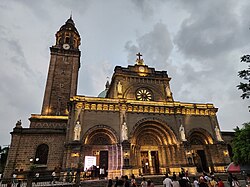 Manila Cathedral Manila Cathedral | |
 Coat of arms Coat of arms | |
| Location | |
| Country | |
| Territory | |
| Ecclesiastical province | Manila |
| Deaneries | 13 (list) |
| Headquarters | Arzobispado de Manila Intramuros, Manila 1002 |
| Coordinates | 14°35′26″N 120°58′15″E / 14.5904202°N 120.9708023°E / 14.5904202; 120.9708023 |
| Statistics | |
| Area | 549 km (212 sq mi) |
| Population - Total - Catholics | (as of 2021) 3,287,728 2,663,060 (81%) |
| Parishes | Around 100 full-fledged parishes, quasi parish, 1 personal parish, chaplaincies, mission stations (mall and condo chapels) |
| Information | |
| Denomination | Catholic |
| Sui iuris church | Latin Church |
| Rite | Roman Rite |
| Established | February 6, 1579; 445 years ago (1579-02-06) (Diocese) August 14, 1595; 429 years ago (1595-08-14) (Archdiocese) |
| Cathedral | Minor Basilica and Metropolitan Cathedral of the Immaculate Conception |
| Patroness | Immaculate Conception |
| Secular priests | 256 |
| Language | English and Filipino |
| Current leadership | |
| Pope | Francis |
| Metropolitan Archbishop | Jose Advincula |
| Suffragans |
|
| Vicar General | Jose Clemente Ignacio Reginald Malicdem |
| Episcopal Vicars |
|
| Bishops emeritus |
|
| Map | |
 Jurisdiction of the metropolitan see within the Philippines. | |
| Website | |
| Archdiocese of Manila | |
| Sources: | |
The Archdiocese of Manila (Latin: Archidioecesis Manilensis; Filipino: Arkidiyosesis ng Maynilà; Spanish: Arquidiócesis de Manila) is the archdiocese of the Latin Church of the Catholic Church in Metro Manila, Philippines, encompassing the cities of Manila, Makati, San Juan, Mandaluyong, Pasay, Taguig (Embo barangays), and Quezon City (EDSA Shrine). Its cathedral is the Minor Basilica and Metropolitan Cathedral of the Immaculate Conception, also known as the Manila Cathedral, located in Intramuros, which comprises the old city of Manila. The Blessed Virgin Mary, under the title Immaculate Conception, is the principal patroness of the archdiocese.
The Archdiocese of Manila is the oldest diocese in the Philippines, created in 1579 as a diocese and elevated as a metropolitan archdiocese in 1595. Since its last territorial changes in 2003, the Archdiocese of Manila is the metropolitan see of the ecclesiastical province of the same name, which also include seven dioceses encompassing other parts of the National Capital Region (Antipolo (Marikina), Cubao, Kalookan, Novaliches, Parañaque, Malolos (Valenzuela), and Pasig) and four dioceses of its surrounding provinces of Cavite (Diocese of Imus), Rizal (Diocese of Antipolo), Bulacan (Diocese of Malolos), and Laguna (Diocese of San Pablo).
In addition, the archdiocese also serves as the de facto overseer of the Military Ordinariate of the Philippines, as well as the Apostolic Vicariates of Puerto Princesa and Taytay in Palawan, all exempt dioceses of the Holy See (with the vicariates under the jurisdiction of the Dicastery for Evangelization).
The archdiocese also owns, operates, and manages institutions, assets, and properties outside its own territorial jurisdiction and located on territories of various dioceses: Mt. Peace and St. Michael Retreat Houses in the dioceses of Baguio and Antipolo, Redemptoris Mater Missionary Seminary Manila in the diocese of Parañaque, the radio station DZRV Radio Veritas 846 kHz and Our Lady of Veritas Chapel in the diocese of Cubao, and Radio Veritas transmitter in the diocese of Malolos. Additionally, the archdiocese is a shareholder of the Bank of the Philippine Islands.
Its suffragan diocese of Malolos in Bulacan, along with the dioceses of San Jose and Cabanatuan in Nueva Ecija (both suffragans of Archdiocese of Lingayen-Dagupan), and Balanga (Bataan), Iba (Zambales) and Tarlac (Tarlac; suffragans of the Archdiocese of San Fernando), form the group of dioceses in Central Luzon.
Since June 24, 2021, Cardinal Jose Advincula is the Archbishop of Manila.
History

Per the efforts of conquistador Martín de Goiti – who founded the City of Manila by uniting the dominions of Sulayman III of Namayan, Sabag, Rajah Ache Matanda of Maynila who was a vassal to the Sultan of Brunei, and Lakan Dula of Tondo who was a tributary to Ming dynasty China – the Diocese of Manila was established on February 6, 1579, through the papal bull Illius Fulti Præsidio by Pope Gregory XIII, encompassing all Spanish colonies in Asia as a suffragan of the Archdiocese of Mexico. Fray Domingo de Salazar, a Dominican from the Convent of San Sebastian in Salamanca, Spain, was selected by King Philip II of Spain to be bishop of the new diocese and was presented to the pope.
Over the course of history and growth of Catholicism in the Philippines, the diocese was elevated and new dioceses had been carved from its territory. On August 14, 1595, Pope Clement VIII raised the diocese to the status of an archdiocese with Bishop Ignacio Santibáñez its first archbishop. Three new dioceses were created as suffragans to Manila: Nueva Cáceres, Nueva Segovia, and Cebu. With the creation of these new dioceses, the territory of the archdiocese was reduced to the city of Manila and the adjoining civil provinces in proximity including Mindoro Island. It was bounded to the north by the Diocese of Nueva Segovia, to the south by the Diocese of Cebu, and to the southeast by the Diocese of Nueva Cáceres.
During the Hispanic period, the archdiocese was ruled by a succession of Spanish and Latino archbishops. In the 1600s, Fr. Joaqin Martinez de Zuñiga, conducted a census of the Archdiocese of Manila which held most of Luzon under its spiritual care, and he reported 90,243 native Filipino tributes; 10,512 Chinese (Sangley) and mixed Chinese Filipino mestizo tributes; and 10,517 mixed Spanish Filipino mestizo tributes. Pure Spaniards are not counted as they are exempt from tribute, with each tribute representing an average family of 6. Out of these, Fr. Joaqin Martinez de Zuñiga exterpolated a total population count exceeding half a million souls.
The British occupation of Manila during the Seven Years' War saw the temporary conversion of Sultan Azim ud-Din I of Sulu to Catholicism, the massive looting and destruction of ecclesiastical treasures, as well as the burning of churches by British soldiers, Sepoy mercenaries, and rebellious Chinese residents in Binondo. This episode was particularly damaging to Philippine scholarship due to the fact that the monasteries holding the archives and artifacts about the pre-colonial Philippine Rajahnates, Kedatuans, Sultanates, Lakanates, and Wangdoms and their conversion to Catholicism were either burnt, lost, or looted by the British. An example would be the Boxer Codex, whose earliest owner Lord Giles of Ilchester had inherited it from an ancestor who stole it from Manila during the British Occupation.
Nevertheless, peace was subsequently restored after the Protestant British occupation. In the time after this, the Catholic religious orders became the powerful driving force in the Archdiocese of Manila (with the exception of the Jesuits who were temporarily suppressed by the Spaniards due to their role in anti-imperialist movements in Latin America) as Jesuits supported the Paraguayan Reductions since Jesuits even supported the natives there against Portuguese and Spanish slavers. The local Filipino diocesan clergy resented the foreign religious orders due to their near monopoly of ecclesiastical positions which violated the declarations of the Catholic Church's Council of Trent, that, once an area is no longer a missionary area but a regular diocese, friars are to surrender the parishes to diocesan priests. However, upon the suppression of the Jesuits, the Recollect Order moving to the parishes once owned by Jesuits, surrendered their parishes to local Filipino diocesan clergy, temporarily assuaging Filipino yearnings. However upon the restoration of the Jesuits, the Recollects were forced to retake their parishes from the diocesans. The opposition of the religious orders against an autonomous diocesan clergy independent of them lead to the martyrdom of Filipino diocesan priests Mariano Gomez, José Burgos, Jacinto Zamora collectively known as Gomburza who were wrongly implicated in the Cavite Mutiny, since the Spanish feared that because a priest, Miguel Hidalgo lead the Mexican war of independence against Spain, the same would happen in the Philippines. Furthermore the Governor General who was a Freemason, Rafael Izquierdo y Gutiérrez upon discovering the Cavite Mutiny was led by fellow Freemasons: Maximo Innocencio, Crisanto de los Reyes, and Enrique Paraiso; the Governor-General as per his Masonic vow to protect fellow brothers of the Craft, shifted the blame to Gomburza since they had inspired ethnic pride among Filipinos due to their campaign for reform. The Governor-General asked the Catholic hierarchy in the person of Archbishop of Manila Gregorio Meliton Martinez to have them declared as heretics and defrocked but he refused as he believed in Gomburza's innocence. As the Imperial government executed Gomburza, churches all across the territory were rung in mourning. This inspired the Jesuit educated and future National Hero Jose Rizal to form the La Liga Filipina, to ask for reforms from Spain and recognition of local clergy.
Rizal was executed and the La Liga Filipina dissolved. As cries for reform were ignored, formerly loyal Filipinos were radicalized and the 1896 Philippine revolution was triggered when the Spanish discovered the anti-colonial secret organisation Katipunan (formed with Masonic rites in mind, and Freemasonry is traditionally Anti-Catholic, yet were dedicated to the martyred priests Gomburza as Gomburza was a password in the Katipunan), the Katipunan waged the revolution leading to the end of Spanish rule. The United States took the Philippines from Spain in the 1898 Spanish–American War; this developed into fighting between the Philippine revolutionaries and the U.S. in the 1899–1902 Philippine–American War, many Katipuneros were devastated that their fellow Masons on the Masonic founded United States Republic killed their fellow Masonic founded Katipunan, this followed by victory for the U.S. and disestablishment of the Roman Catholic Church as the state church of the Philippines. In the period after the war, Philippine churches were restored in the Art-Deco architectural motif. There was a looming threat of apostasy and schism with the rise of anti-clerical Philippine Freemasonry and the establishment of the Philippine Independent Church due to Filipino anger against Spanish ecclesiastical corruption. In response, the Vatican supported Philippine independence and applied a policy of reinforcing orthodoxy and reconciliation which resulted in the majority of the Filipinos remaining faithful to the Roman Catholic Church and having a good number of those separated from the Church grafted back.

The province of Mindoro was established as an independent diocese on April 10, 1910, by virtue of a Decretum Consistoriale signed by Pope Pius X, implementing the bull Quae Mari Sinico of Pope Leo XIII. On the same date, the Diocese of Lipa was created, with jurisdiction over the provinces of Batangas, Tayabas, Marinduque, and some parts of Masbate. In May 1928, Pope Pius XI established the Diocese of Lingayen, carved from Manila and Nueva Segovia. In this creation, 26 parishes were separated from Manila. He also named Our Lady of Guadalupe as a patroness of the Filipino people in 1938.
December 8, 1941, marked the beginning of the Japanese occupation of the Philippines. World War II marked a period of irreplaceable loss to the Archdiocese of Manila. The combination of violent theft and arson done by the Japanese and indiscriminate carpet bombing by the Americans during the Battle of Manila (1945) led to the permanent loss of many of the ancient Gothic, Art-Deco, and Earthquake Baroque churches.

In the aftermath of the war, in September 1942, Pope Pius XII declared Our Lady of Immaculate Conception as the Principal Patroness of the Philippines by virtue of the papal bull, Impositi Nobis, along with Pudentiana and Rose of Lima as secondary patrons.
Due to the heavy damages resulting from World War II, the Manila Cathedral underwent major rebuilding from 1946 to 1958. The Parish of San Miguel served as pro-cathedral or temporary cathedral of the local church until the Manila Cathedral was reopened and consecrated in 1958.
On December 11, 1948, the Apostolic Constitution Probe Noscitur further divided the Archdiocese of Manila by placing the northern part of the local church in the new Diocese of San Fernando. On November 25, 1961, the Archdiocese of Manila was again partitioned with the creation of the Diocese of Malolos for the province of Bulacan in the north and the Diocese of Imus for the province of Cavite in the South.
Pope John Paul II declared the Manila Cathedral a minor basilica in 1981 through the motu proprio Quod ipsum, issued as a papal bull. In 1983, the province of Rizal, together with the city of Marikina and the northeastern part of Pasig, was placed under the new Diocese of Antipolo.
The archdiocese witnessed many grace-filled church events such as the Second Synod of Manila (1911), the Third Synod of Manila (1925), the 33rd International Eucharistic Congress (1937), the First Plenary Council of the Philippines (1953), the papal visit of Pope Paul VI (1970), the Fourth Synod of Manila (1979), the papal visits of Pope John Paul II (the first in 1981 and the second in 1995), the National Marian Year (1985), the National Eucharistic Year (1987), the Second Plenary Council of the Philippines (1991), the Second Provincial Council of Manila (1996), the 4th World Meeting of Families (2003), and the papal visit of Pope Francis (2015).
In 2002, two more dioceses were carved out of the Archdiocese: the Diocese of Novaliches and the Diocese of Parañaque. In 2003, three more dioceses were erected: Cubao, Kalookan, and Pasig.
Coat of arms
The arms of the metropolitan see of Manila is an adaptation of the arms granted by Philip II of Spain to the "insigne y siempre leal (distinguished and ever loyal)" city of Manila in 1596. The silver crescent represents the Immaculate Conception, patroness of the Manila Cathedral and of the entire Philippines. The tower represents God himself whom the psalmist calls in Psalms 60 turris fortis contra inimicum (turris fortitudinis a facie inimici in the Gallician psalter). The three windows make the tower represent the Blessed Trinity: Father, Son and Holy Ghost, three Persons in one God. The sea lion represents the Philippines, then-an overseas territory of Spain, and the pilgrim's cross which may be easily fixed on the ground symbolizes both the faith of the Filipino people and their missionary role in spreading that faith.
Archbishops
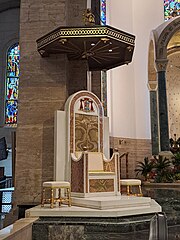
The seat of the archbishop is at Manila Cathedral. After the first bishop of Manila Domingo de Salazar, the diocese became an archdiocese and there have been nineteen archbishops of Spanish origin. In 1903, the archdiocese received its first American archbishop, Jeremiah James Harty from St. Louis, Missouri. After him, the Irishman Michael J. O'Doherty was appointed in 1916. O'Doherty would lead the church during a period when Filipinos were petitioning for sovereignty from the United States and during the Japanese occupation of the Philippines during World War II.
When O'Doherty died after Philippine independence in 1946, the coadjutor archbishop Gabriel Reyes became the first native Filipino in the position. Reyes' successor, Archbishop Rufino Jiao Santos, became the first Filipino to become a cardinal in 1960. Since then, all archbishops were of Filipino origin and were created cardinals.
After the departure of Cardinal-Archbishop Luis Antonio Tagle to assume the position as prefect of Congregation for the Evangelization of Peoples in February 9, 2020, Auxiliary Bishop Broderick Pabillo lead the archdiocese as apostolic administrator for 17 months during the COVID-19 pandemic, until Tagle's successor, then-Archbishop of Capiz José Fuerte Advíncula, took office in June 24, 2021.
List of Archbishops of Manila
| No. | Name | From | Until | |
|---|---|---|---|---|
| 1 | 
|
Domingo de Salazar, O.P. | February 6, 1579 | December 4, 1594 |
| 2 | 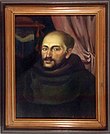
|
Ignacio Santibáñez, O.F.M. | August 30, 1595 | August 14, 1598 |
| 3 | 
|
Miguel de Benavides, O.P. | October 7, 1602 | July 26, 1605 |
| 4 | 
|
Diego Vázquez de Mercado | May 28, 1608 | June 12, 1616 |
| 5 | 
|
Miguel García Serrano, O.S.A. | February 12, 1618 | June 14, 1629 |
| 6 | 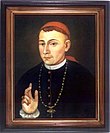
|
Hernando Guerrero, O.S.A. | January 9, 1634 | July 1, 1641 |
| 7 | 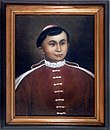
|
Fernando Montero Espinosa, O.P. | February 5, 1646 | 1648 |
| 8 | 
|
Miguel de Poblete Casasola | January 21, 1649 | December 8, 1667 |
| 9 | 
|
Juan López Galván | November 14, 1672 | February 12, 1674 |
| 10 | 
|
Felipe Fernández de Pardo, O.P. | October 28, 1681 | December 31, 1689 |
| 11 | 
|
Diego Camacho y Ávila | August 19, 1696 | January 14, 1704 |
| 12 | 
|
Francisco de la Cuesta, O.S.H. | August 12, 1707 | September 27, 1723 |
| 13 | 
|
Carlos Bermúdez de Castro y González | November 20, 1724 | November 13, 1729 |
| 14 | 
|
Juan Ángel Rodríguez, O.Ss.T. | May 18, 1731 | June 24, 1742 |
| 15 | 
|
Pedro de la Santísima Trinidad Martínez de Arizala, O.F.M. | February 3, 1744 | May 28, 1755 |
| 16 | 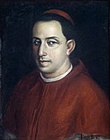
|
Manuel Rojo del Río y Vieyra | December 19, 1757 | January 30, 1764 |
| 17 | 
|
Basílio Sancho de Santa Justa, Sch.P. | April 14, 1766 | December 15, 1787 |
| 18 | Juan Antonio Orbigo de Gallego, O.F.M. | December 15, 1788 | May 17, 1797 | |
| 19 | Juan Antonio Zulaibar, O.P. | March 26, 1804 | March 4, 1824 | |
| 20 | 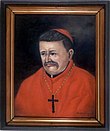
|
Hilarión Díez, O.S.A. | July 3, 1826 | May 7, 1829 |
| 21 | 
|
José Seguí, O.S.A. | July 5, 1830 | July 4, 1845 |
| 22 | 
|
José Julián de Aranguren, O.A.R. | January 19, 1846 | April 18, 1861 |
| 23 | 
|
Gregorio Melitón Martínez Santa Cruz | December 23, 1861 | September 30, 1875 |
| 24 | 
|
Pedro Payo y Piñeiro, O.P. | January 28, 1876 | January 1, 1889 |
| 25 | 
|
Bernardino Nozaleda y Villa, O.P. | May 27, 1889 | February 4, 1902 |
| 26 | 
|
Jeremiah James Harty | June 6, 1903 | May 16, 1916 (Transferred to Diocese of Omaha) |
| 27 | 
|
Michael J. O'Doherty | September 6, 1916 | October 13, 1949 (Died in office) |
| 28 | Gabriel Reyes | October 13, 1949 | October 15, 1952 (Died in office) | |
| 29 | 
|
Rufino Cardinal Santos | February 10, 1953 | September 3, 1973 (Died in office) |
| 30 | 
|
Jaime Cardinal Sin | March 19, 1974 | November 21, 2003 (Retired) |
| 31 | 
|
Gaudencio Cardinal Rosales | November 21, 2003 | December 12, 2011 (Retired) |
| 32 | 
|
Luis Antonio Cardinal Tagle | December 12, 2011 | February 9, 2020 (Became prefect of the Congregation for the Evangelization of Peoples) |
| 33 | 
|
José Cardinal Advíncula, O.P. | June 24, 2021 | present |
Coadjutor Archbishops
- Romualdo J. Ballesteros (1845–1846), did not succeed to see; appointed Bishop of Cebu
- Gabriel M. Reyes (1949–1952)
Auxiliary Bishops
- Ginés Barrientos (1680–1698)
- Jose Maria Segui Molas (1829–1830), appointed 21st Archbishop of Manila
- William Finnemann (1929–1936), appointed Prefect of Mindoro
- Cesar Maria Guerrero y Gutierrez (1937–1949), appointed Bishop of San Fernando
- Rufino Jiao Santos (1947–1953), appointed 29th Archbishop; made Cardinal by John XXIII in 1960
- Vicente Posada Reyes (1950–1961), appointed Bishop of Borongan
- Hernando Izquierdo Antiporda (1954–1975)
- Pedro Bantigue y Natividad (1961–1967), appointed Bishop of San Pablo
- Bienvenido M. Lopez (1966–1995)
- Artemio G. Casas (1968–1974), appointed Archbishop of Jaro
- Amado Paulino y Hernandez (1969–1985)
- Gaudencio Borbon Rosales (1974–1982), appointed Coadjutor Bishop of Malaybalay; later appointed 31st Archbishop; made Cardinal by Benedict XVI in 2006
- Oscar Valero Cruz (1976–1978), appointed Archbishop of San Fernando
- Protacio G. Gungon (1977–1983), appointed Bishop of Antipolo
- Leonardo Legaspi (1977–1984), appointed Archbishop of Caceres (Nueva Caceres)
- Manuel C. Sobreviñas (1979–1993), appointed Bishop of Imus
- Gabriel V. Reyes (1981–1992), appointed Bishop of Kalibo
- Teodoro J. Buhain, Jr. (1983–2003)
- Teodoro Bacani (1984–2002) appointed Bishop of Novaliches
- Leoncio L. Lat (1985–1992)
- Ramon Arguelles (1993–1995), appointed Military Ordinary of the Philippines
- Crisostomo A. Yalung (1994–2001), appointed Bishop of Antipolo
- Rolando Joven Tria Tirona (1994–1996), appointed Bishop of Malolos
- Jesse E. Mercado (1997–2002), appointed Bishop of Parañaque
- Socrates B. Villegas (2001–2004), appointed Bishop of Balanga
- Bernardino C. Cortez (2004–2014), appointed Prelate of Infanta
- Broderick S. Pabillo (2006–2021) appointed Vicar Apostolic of Taytay
Priests of this diocese who became bishops
- Francisco Sales Reyes y Alicante, appointed Bishop of the Archdiocese of Nueva Caceres (now Archdiocese of Caceres) in 1925
- Artemio Gabriel Casas, appointed 1st Bishop of Imus in 1961; later returned to the archdiocese as auxiliary bishop
- Felix Paz Perez, appointed 2nd Bishop of Imus in 1969
- Antonio Realubin Tobias, appointed auxiliary bishop of Zamboanga in 1982, then bishop of the Diocese of Pagadian, Diocese of San Fernando in La Union, and finally Diocese of Novaliches until retirement in 2019
- Francisco Capiral San Diego, appointed Coadjutor Vicar Apostolic of Palawan in 1983, then became Apostolic Vicar of Apostolic Vicariate of Puerto Princesa, 2nd bishop of the Diocese of San Pablo, Laguna and later 1st bishop of the Diocese of Pasig.
- Mylo Hubert Claudio Vergara, appointed Bishop of Diocese of San Jose in Nueva Ecija in 2005, and later appointed bishop of the Diocese of Pasig (April 20, 2011 – present)
- Francisco Mendoza de Leon, Auxiliary Bishop of the Diocese of Antipolo (September 1, 2007 – November 21, 2015), Coadjutor Bishop of Antipolo (November 22, 2015 – September 10, 2016) and 4th Bishop of the Diocese of Antipolo (September 10, 2016 – July 22, 2023).
- Socrates Villegas, 3rd Bishop of the Diocese of Balanga (May 3, 2004 – November 4, 2009) and 5th Archbishop of the Archdiocese of Lingayen-Dagupan (November 4, 2009 – present)
- Ruperto Cruz Santos, 4th Bishop of the Diocese of Balanga (April 1, 2010 – July 22, 2023), 5th Bishop of the Diocese of Antipolo (July 22, 2023 – present)
- Roberto Orendain Gaa, 3rd Bishop of the Diocese of Novaliches (August 24, 2019 – present)
- Jose Alan Verdejo Dialogo, 5th Bishop of the Diocese of Sorsogon (October 15, 2019 – present)
- Arnaldo Catalan, Apostolic Nuncio to Rwanda (January 31, 2022 – present)
- Rufino Sescon Jr, 5th Bishop of the Diocese of Balanga (Bishop-Elect)
Formation of priests
The archdiocese administers San Carlos Seminary, the archdiocesan major seminary which caters to the formation of future priests for the archdiocese and for its suffragan dioceses. Located in Guadalupe Viejo, Makati, it has a pre-college program (senior high school and formation year), a college program (A.B., philosophy), and a graduate school (master's program in theology or pastoral ministry), as well as a formation houses for future priests committed to serve the Filipino-Chinese communities in the country (Lorenzo Ruiz Mission Society) and a center for adult vocations (Holy Apostles Senior Seminary). The archdiocese also operates Our Lady of Guadalupe Minor Seminary for young men at the secondary school level. It is located a few blocks from San Carlos Seminary.
Schools
The Roman Catholic Archbishop of Manila Educational System (RCAMES) comprises 27 archdiocesan and parochial schools. The archbishop of Manila exercises authority in each member school and appoints a superintendent for the entire system to implement decisions and resolve issues. The member schools are:
- Ermita Catholic School
- Espiritu Santo Parochial School
- Guadalupe Catholic School
- Holy Child Catholic School
- Holy Family Parochial School
- Holy Trinity Academy
- Jaime Cardinal Sin Learning Center
- Malate Catholic School
- Manila Cathedral School
- Our Lady of Fatima Catholic School
- Our Lady of Guadalupe Minor Seminary
- Paco Catholic School
- Sacred Heart of Jesus Catholic School
- Saint Anthony School
- Saint Joseph School - Gagalangin
- Saint Joseph's School of Pandacan
- Saint Peter the Apostle School
- Saint Pius X Parochial School
- San Felipe Neri Parochial School
- San Isidro Catholic School
- San Juan de Dios Educational Foundation
- San Pablo Apostol Learning Center
- San Rafael Parochial School
- Santa Clara Parish School
- Santa Isabel College
- St. John the Baptist Catholic School
- The Nazarene Catholic School
See also
- List of Catholic dioceses in the Philippines
- Catholic Church in the Philippines
- The Royal and Conciliar San Carlos Seminary
References
- "Manila (Catholic Metropolitan Archdiocese)". gcatholic.org. Retrieved September 16, 2023.
- "Manila (Archdiocese)". Catholic-Hierarchy.org. David M. Cheney. Retrieved May 3, 2023.
- "Appointment of Episcopal Vicars and Vicars Forane". Retrieved June 10, 2023.
- "Vicariates and Parishes". Retrieved May 8, 2023.
- "$BPI Top 100 Stockholders as of June 24, 2024". PSE. Retrieved October 14, 2024.
- Depasupil, William (June 24, 2021). "Cardinal Advincula installed as 33rd Manila archbishop". The Manila Times. Retrieved June 24, 2021.
- "History – the First Cathedral 1581–1583 Archived May 24, 2013, at the Wayback Machine. Manila Metropolitan Cathedral-Basilica Official Website. Retrieved on March 22, 2013.
- de Achútegui, Pedro S. (1979). "A Problem of Chronology: The Quadricentennial of Manila and the Gregorian Calendar". Philippine Studies. 27 (3): 417–431. ISSN 0031-7837. JSTOR 42632495.
- "History – The Second Cathedral 1591–1600". Manila Metropolitan Cathedral-Basilica Official Website. Retrieved on March 22, 2013.
- ^ "ESTADISMO DE LAS ISLAS FILIPINAS TOMO PRIMERO By Joaquín Martínez de Zúñiga (Original Spanish)" (PDF). Archived (PDF) from the original on March 9, 2016. Retrieved February 3, 2024.
- Roces, Alfredo R., ed. (1977). "Boxer Codex". Filipino Heritage: the Making of a Nation. Vol. IV. Philippines: Lahing Pilipino Publishing. p. 1004.
- ^ Escalante, Rene (May 12, 2020). "WATCH: GOMBURZA an NHCP Documentary" (video). youtube.com. National Historical Commission of the Philippines.
- "Pope Orders Sharp Action; Archbishop of Manila Instructed to Excommunicate Philippine National Church Promoters", New York Times, New York: December 29, 1902. p. 7
- MacArthur General Staff (1994). "The Japanese Offensive in the Philippines". Report of General MacArthur: The Campaigns of MacArthur in the Pacific Volume I. GEN Harold Keith Johnson, BG Harold Nelson, Douglas MacArthur. United States Army. p. 6. LCCN 66-60005. Archived from the original on February 12, 2009. Retrieved March 24, 2013.
- Quezon III, Manuel L. (February 7, 2007). "The Warsaw of Asia: How Manila was Flattened in WWII". Jeddah, Saudi Arabia: Arab News Online (archive.arabnews.com). Opinion. Archived from the original on March 30, 2012. Retrieved August 7, 2010.
- Pope Pius XII (1942). 34 [1942] - ocr.pdf "Acts of the Apostolic See – Insularum Philippinarum Beatissima Virgo Maria Titulo Immaculata Concepto Primaria Universalisque Patrona et Sanctae Virgines' Pudentiana ac Rosa Limanae Patronae Secundarias Declarantur", pp. 336–337. Vatican Archives. Retrieved on March 22, 2013.
- "The Manila Cathedral". manilacathedral.com.ph. Retrieved June 21, 2021.
- Madriaga, Mariano (1957). "The Coats-of-Arms of the Ecclesiastical Jurisdictions in the Philippines: Part I. The Metropolitan Sees". Philippine Studies. 5 (2): 177–190. JSTOR 42720389. Retrieved June 5, 2021.
- "Cardinal Advincula of Capiz named Manila archbishop". Catholic Church. Rappler. March 25, 2021. Retrieved March 25, 2021.
- Santos, Tina (February 10, 2020). "Cardinal Tagle celebrates last Mass as Manila archbishop". Philippine Daily Inquirer.
- "Establishment of the Educational System of the Archdiocese of Manila". Roman Catholic Archdiocese of Manila Educational System. Retrieved December 26, 2021.
- Sources
- Population of the Archdiocese of Manila Statistics of Manila Archdiocese
- Official website
- Herbermann, Charles, ed. (1913). "Archdiocese of Manila" . Catholic Encyclopedia. New York: Robert Appleton Company.
- Gregory XIII, Pope, 1502–1585. "Bull for erection of the Diocese and Cathedral Church of Manila." In The Philippine Islands, 1493–1898. Cleveland, Ohio: A.H. Clark Company, 1903–9. Vol. 4, 1576–82. pp. 119–124.
- 5 Seminaries under the Archdiocese of Manila
COFOR – The Roman Catholic Archdiocese of Manila
External links
| Roman Catholic Archdiocese of Manila | |||||||||||||||||||||||||||
|---|---|---|---|---|---|---|---|---|---|---|---|---|---|---|---|---|---|---|---|---|---|---|---|---|---|---|---|
| Archidioecesis Manilensis | |||||||||||||||||||||||||||
| Territories |  | ||||||||||||||||||||||||||
| Ordinaries |
| ||||||||||||||||||||||||||
| Cathedrals | |||||||||||||||||||||||||||
| Basilicas | |||||||||||||||||||||||||||
| Shrines |
| ||||||||||||||||||||||||||
| Parishes |
| ||||||||||||||||||||||||||
| Abbeys | |||||||||||||||||||||||||||
| Images |
| ||||||||||||||||||||||||||
| Properties |
| ||||||||||||||||||||||||||
| Suffragan dioceses | |||||||||||||||||||||||||||
| Catholic dioceses in the Philippines | |
|---|---|
| Listed by ecclesiastical province with the metropolitan archdioceses in yellow and their suffragan dioceses in white | |
| Cáceres | |
| Cagayan de Oro | |
| Capiz | |
| Cebu | |
| Cotabato | |
| Davao | |
| Jaro | |
| Lingayen-Dagupan | |
| Lipa | |
| Manila | |
| Nueva Segovia | |
| Ozamis | |
| Palo | |
| San Fernando | |
| Tuguegarao | |
| Zamboanga | |
| Apostolic vicariates | |
| Military ordinariate | |
| Other | |
14°35′29″N 120°58′25″E / 14.59139°N 120.97361°E / 14.59139; 120.97361
Categories: